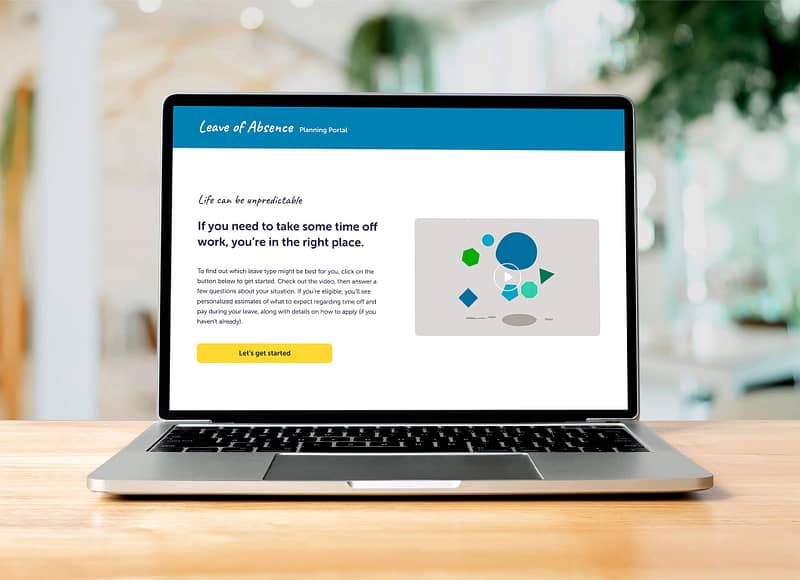Over the last two years, workers have had many reasons to take an extended leave of absence from work – supervising children while schools and daycares are closed, caring for older family members, recovering from COVID-19, or managing their mental health. (Thankfully, it’s not entirely bad news, since we’ve also seen more folks taking leave as a result of a recent baby boom.)
Taking leave is often a stressful situation for employees. Most people don’t know how many weeks of leave they’re entitled to, whether (or how much) they’ll get paid, or whether their benefits will still apply.
Unfortunately, the leave of absence process is pretty complicated for us as employers too—which means many of us struggle to communicate this benefit to our employees. Information on leave of absence benefits is often hard to find – usually buried somewhere deep in the benefits guide – and written in the benefits jargon that employees have come to know and hate.
Luckily, there’s a better way. Let’s talk about what that looks like, and what challenges you can overcome along the way.
Leave of absence benefits are hard to communicate
Before we get too far, it’s important to discuss why leave of absence benefits are so hard to talk about. There are five basic reasons:
- It’s confusing! Coordinating leave of absence is quite complicated. Multiple federal, state, and local laws may affect a single leave of absence request, and legal requirements may overlap – or contradict each other. Plus, the rules may change at any time.
- It’s new territory. HR pros may be well versed in leave of absence requests, but most employees will only file one or two requests in their professional careers. Understandably, they don’t know the ins and outs of the law.
- It’s a gray area. Companies can require employees to use accumulated leave (sick time, vacation time, or paid time off) before a leave of absence request is approved. Workers may request leave, only to find out they don’t qualify under company policy.
- It’s different for every company. While the Americans with Disabilities Act (ADA) and the Family Medical Leave Act (FMLA) cover mandatory leave, voluntary leave – from bereavement to sabbatical – is up to employers to define.
- It’s deeply personal. Employees tend to request leave when they need to handle difficult times in their lives. That makes it a hard thing to discuss at work, even in the privacy of a closed-door meeting with HR.
5 steps to help employees navigate the process:
Clearly, there’s value in helping employees better understand their leave of absence options. Employees who know that they can take leave, and that the company will support their decision, are more comfortable asking for help. Instead of being unproductive because they’re stressed out, sick, distracted, or simple disengaged, they can leave the time they need that will allow them to return to work refreshed and refocused.
There are a few simple things you can do to help employees navigate the leave of absence process.
1. Provide clear definitions
Our post on leave of absence definitions goes into a lot of detail, so here’s a quick summary of the two main types of unpaid leave. Remember: The simpler the definition, the better.
Mandatory leave is protected by law. This includes:
- Parental leave for a newborn or recently adopted or fostered child. (Some states go above and beyond the federal law by required paid leave.)
- Medical leave to take care or yourself or a family member with a serious health condition.
- Military leave for active military service, training, and other duties. This applies to those serving in the Regular Armed Forces and the National Guard or Reserves.
- Military caregiver leave to care for a service member with a serious illness or injury.
- Disability leave to recover from an illness, receive medical treatment, train a service animal, or avoid temporary adverse conditions in the workplace.
Voluntary leave is at the employer’s discretion. It is not required by law, but voluntary leave is a valuable benefit that can boost morale, improve employee retention, and help attract new employees. Examples include the following:
- Bereavement is typically offered for immediate family members but could also cover the loss of a pet, the end of a close personal relationship, or a significant medical diagnosis.
- Sabbatical allows employees to take time off to travel, volunteer, learn new skills, or otherwise unwind without fear of losing their job.
- Jury duty leaves covers employees who are selected to serve on a jury. (Requirements for paid leave vary by state.)
- Education leave is similar to sabbatical but specifically refers to time off to pursue higher education, such as a master’s degree or a certificate program.
- Relocation leave lets employees take approved time off to move without falling behind on work.
2. Personalize messaging
The most effective messaging about leave of absence answers three questions: How much time can I take, will I be paid, and how will this impact my job? Any communication that can’t address these pressing needs will only cause frustration and confusion.
It’s also important to look at what you say and how you say it. Employees take leave at emotional times; in this state, it’s critical to communicate in simple language and with a sympathetic tone. Ditch the form letters, address employees by name, and provide clear explanations based on their unique situation.
Provide clear action items depending on why they’re taking leave, such as who to call, how to apply, and where to go for more information.
3. Create a clear process
The easier it is for employees to learn about and apply for leave, the more likely they are to take leave when they truly need it. This gives employees peace of mind knowing that you have their back – and it helps the company, since they’re more focused once they return to work.
Here are a few tips for creating a leave of absence process:
- Don’t force employees to read a lot of text or sift through a list of links to find the information they need.
- Make information accessible 24/7 so employees can read it at their convenience and with their loved ones.
- Educate managers about the basics of leave of absence policies, since employees are likely to go to them first instead of HR.
- Provide a glossary of terms that’s written in plain English. (Or Spanish, Mandarin, or other languages, depending on your workforce.)
- Offer leave of absence request forms with all the hard-to-find information filled in. Ideally, employees should only need to enter the type of leave requested and the dates of leave.
- Establish a policy of ongoing communication – the last thing you want is for employees to think that their questions have gone unanswered.
4. Keep in touch
While companies aren’t required to keep tabs on employees who are out on leave, it’s a good idea to keep in touch. This is partly to ensure FMLA compliance, as employees on leave due to a serious health condition will need a medical release to return to work. Communication also helps avoid contentious situations, as it gives HR professionals written documentation of any ongoing developments.
But it’s also good for morale. Sympathy cards, care packages, or flowers will let employees who are going through tough times know that you’re thinking of them. And gifts for a new baby, new home, or college graduation show that your company is happy to celebrate alongside employees who are reaching significant life milestones. As a SHRM resource put it, this gets to the “human” part of HR.
5. Build a leave of absence hub
One of the easiest ways to bring clarity to the leave of absence process is to create a single resource for everything employees will need. You’ll want to include educational material, FAQs, forms, links to important federal or state websites, and so on.
You could create a special page on your intranet. But your employees want something that’s engaging, readily accessible, and easy to use – and you and your HR colleagues want something that they don’t have to spend all their time managing and updating.

That’s where the purpose-built Leave of Absence Hub enters the picture. Available from Jellyision Custom Solutions, the Hub gives employees the one-stop shop they need right from their smartphones, complete with an intelligent chatbot available to answer questions day or night.


